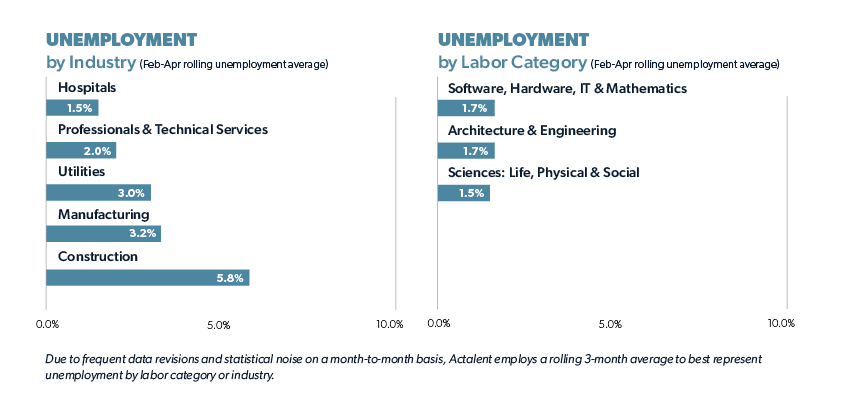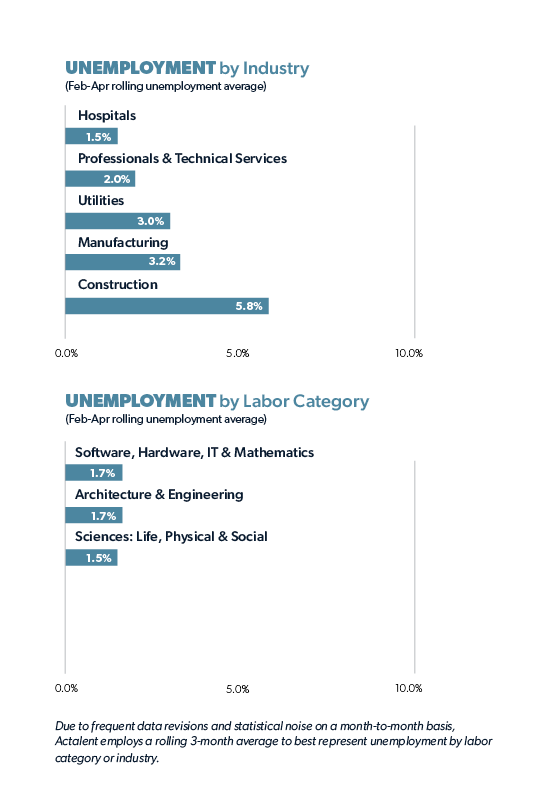April 2022 Market Brief: Real Earnings Shrinking. More Jobs than Workers.
Actalent's Economy & Labor Market Brief: April 2022
Welcome to Actalent’s Market Matters Brief, April 2022 edition, where we share insights into some of the most important conversations happening in the economy and labor market and help connect the dots about why it matters to you.
Listen to the Brief:
In the entertainment industry, a logline provides a short, one-or-two sentence summary of a film's hook and central conflict. For fun (because who couldn't use a little fun these days), if the labor market were a film, here are TWO loglines for this month's multi-conflict report:
- Despite record inflation, despite interest rate increases, and despite skyrocketing credit card debt, lost workers are not returning to the labor market at the rate experts predicted—and no one really knows why.
- If you want a job, you can get a job. And if you want to quit that job in search of better job with higher pay, sweeter benefits, improved work-life balance, or just a healthier culture, you can probably do that too. (Actually, you probably already are.)
Big Picture Labor Market
Job Openings > Available Workers
Inflation > Real Earnings
Overall, April's job gains were higher than expected—but 428,000 doesn't touch the reported 11.5 million current job openings in the U.S. economy. Nor does it make up for the more than 363,000 eligible workers that stopped participating in the labor force one month after March's encouraging increase.
And the people who are participating? They keep quitting. Quit rates in March tied November's previous high of 4.5 million and mark the eighth consecutive month of job quits in the 4M range.
Hourly wage increases were moderate this month ($0.10 cents in April compared to March's $0.13 cents). Even with wages up 5.5 percent year-over-year, real earnings aren't close to catching inflation rates, which continue to rise. April showed an increase of 8.3 percent above last year's rate—higher than predicted but lower than last month in part due to lower gas prices in April and in other part due to a statistical quirk. According to the New York Times (Smialek, 2022), “Yearly price increases are now being measured against elevated price readings from last spring, when inflation started to take off. The high base makes annual increases look less severe.”
Engineering and Sciences Labor Market
You can download the full set of data from our market analytics team for a more in-depth look at the engineering and sciences labor market in specific industries. Here are a few items to note from that report:
Engineering and Sciences Unemployment
Engineering and sciences workers are in high demand, it's still tough to find them. Unemployment rates among these workers are low, low, low.
Overall Unemployment Rate: 3.6%
Engineering and Sciences Employment Trends
- Demand for Architecture and Engineering workers was up in April—and these engineers have options. Many engineering specialties (electrical, software, mechanical, etc.) had similar postings from nearly two thousand competitors. Even with graduation season in full swing, engineers won’t come cheap. New York Fed recently released its labor market data for recent college graduates and engineers claim nine of the top ten occupations with highest early career salaries.
- Recently released details regarding the Infrastructure Bill reveal tremendous opportunity for funding and projects in the Utilities industry, but much stricter environmental regulations as a condition of approval. In other words, companies looking to take on this work can’t just hire a skill, they need to hire a complement of them with varied expertise, knowledge, and capabilities (e.g., civil engineers, construction manager, designers, drafters, environmental engineer, project manager, etc.).
- The Life Sciences industry added more than 40K jobs between healthcare and scientific research and development—and as is the case for many industries, have far more openings than workers to fill them. For example, 46.7K job postings appeared for Medical Assistants between March and April (from roughly 6.5K competing companies).
- The Automotive industry added more than 6K workers last month. Connected, Autonomous, Shared, and Electric (CASE) trends continue to shape this industry with Ford announcing plans for their Alexa Built-In AI feature. Of course, all eyes are on shutdowns and supply chain issues, which continue to wreak havoc on the industry and frustrate consumers of all kinds. The Wall Street Journal reported on the part shortages that are holding up the trucking industry, thereby contributing to struggles in moving freight. Of note from the report: truck manufacturers have accepted about 55 percent fewer orders than during the early months of 2021, resulting in many trucking companies to turn away business.
Connecting the Dots
- Rising costs. Higher salaries mean higher costs of service. An article in the Wall Street Journal this week, and cited here, reported on expected increases in hospital services to offset increases in nursing salaries, a trend that won’t likely be limited to the healthcare industry as companies try and attract talent and offset inflation surges. The Fed took an aggressive step toward combating inflation, increasing interest rates by one-half percent rather than the one-quarter percent it planned. In reference to last month’s Market Matters Brief, looks like the inflation plane is adjusting altitude in-flight.
- Skills gap. As reported in previous Actalent publications, every industry is now a tech industry. Not surprising, a new report published by Deloitte indicates that the integration of new digital technologies in this industry has contributed to the skills gap. Not only are companies hard-pressed to find new talent, but they’ll also need to upskill the talent they have.
- Applying for flexibility. For generations, people have wanted freedom to choose where they work, their purpose for working, who they work with, and what exactly they work on. The last couple of years gave many the opportunity to think about how to make that happen. Today, companies aren’t just competing against other big companies for talent. They’re competing against entrepreneurship, those who’ve struck out on their own—consultants, contractors, freelancers. According to BLS, applications for Employer Identification Numbers—often the first step toward entrepreneurship— have skyrocketed. In March 2022, applications for EINs were up by more than 40 percent compared with the monthly average in 2019. As more and more businesses rethink their talent strategies in effort to address the talent shortage, tapping into the “why” behind this phenomenon might be a great place to start.
References: Smialek, J. (2022, May 10). Consumer Prices are Still Climbing Rapidly. The New York Times.
Past Issues:
- September 2021
- August 2021
- October 2021
- November 2021
- December 2021
- January 2022
- February 2022
- March 2022
Actalent's April 2022 Market Matters synthesizes information from a variety of sources including the United States Bureau of Labor Statistics survey results, Emsi-Burning Glass, media reports, industry intelligence, company earnings reports, and external labor market data. The full set of data is included as a companion to this article.
If you'd like more information on the data presented, or have questions about the information provided in this report, please contact our team at: content@actalentservices.com.




